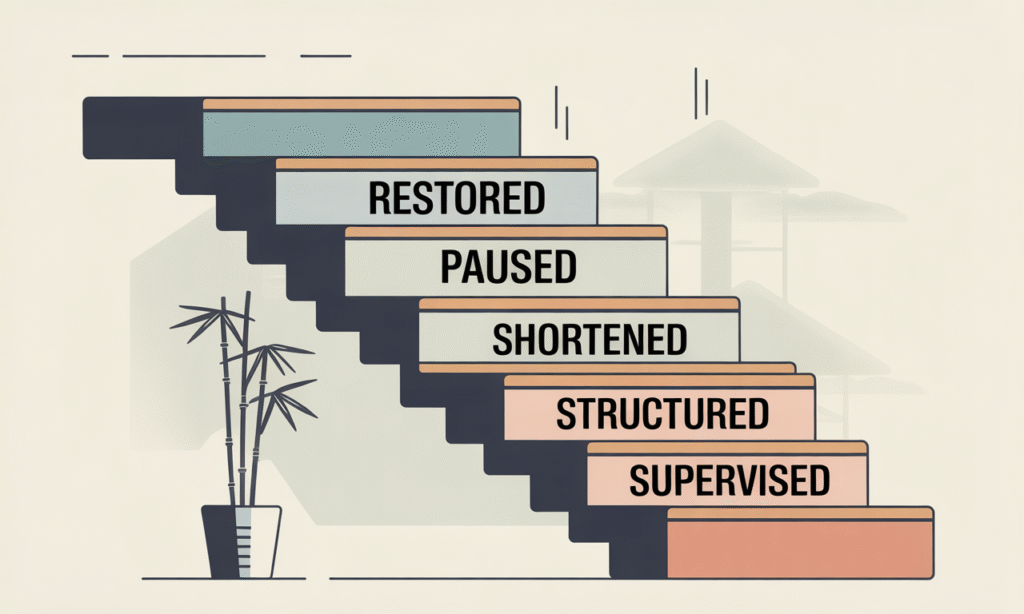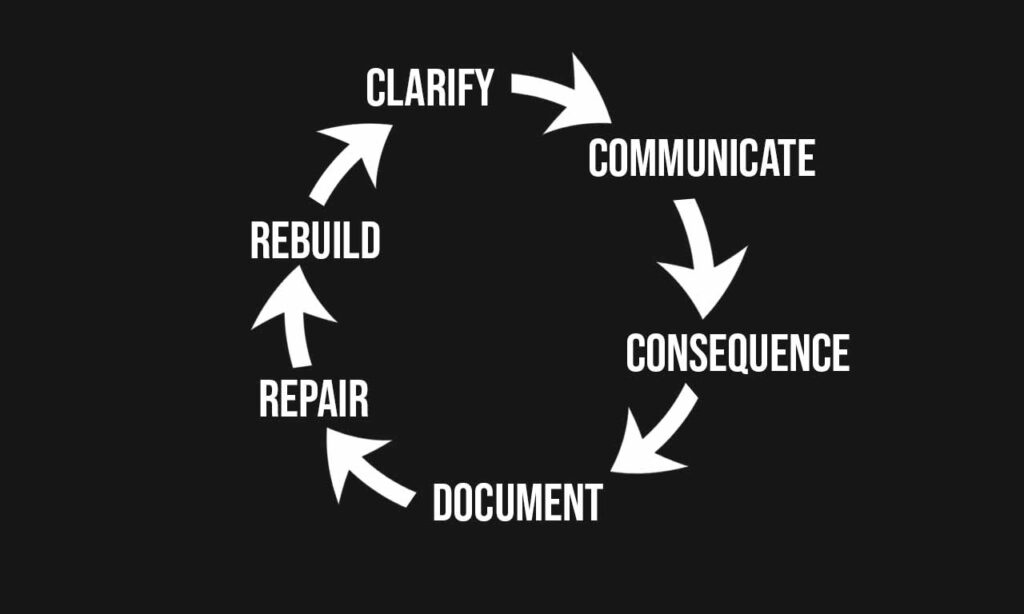When They Won’t Respect the Boundary: Consequences, Repair, and a Path Back

What if you’ve been clear, kind—and still ignored? This guide shows you how to set proportionate, predictable consequences that protect your child without torching the relationship. You’ll learn how to scale contact (supervised, shortened, or paused), document the path back (what “repair” looks like), and communicate hope: “We want this to work. Here’s how we can rebuild trust.” Boundaries aren’t punishments; they’re bridges back to safe connection.
When They Won’t Respect the Boundary: Why It Hurts So Much
 When a grandparent breaks a clearly stated boundary—especially one connected to your child’s well-being—it feels like betrayal dressed up as love. You think, We’ve talked about this so many times. Why doesn’t it stick?
When a grandparent breaks a clearly stated boundary—especially one connected to your child’s well-being—it feels like betrayal dressed up as love. You think, We’ve talked about this so many times. Why doesn’t it stick?
It hurts not just because of the action but because of the meaning behind it: disregard, dismissal, or defiance. You’re not only protecting bedtime or sugar limits—you’re protecting the authority structure of your home.
And yet, when we treat boundary-breaking as rebellion rather than relationship drift, we lose the chance for healing. The key is to remember this: The goal is not compliance—it’s alignment.
You want your parents (or in-laws) to understand that your boundaries are expressions of love, not rejection. You want to protect your children without declaring war on your family.
For the full framework on why boundaries matter in the first place, start with the cornerstone post, The Grandparent Boundary Playbook: Protecting Your Parenting Without Blowing Up the Family. That cornerstone teaches how to set limits with calm clarity—this post shows what to do when those limits aren’t honored.
The Anatomy of Boundary Violation
 Not all boundary breaches are equal. Some are thoughtless, some are willful, and some are repeated patterns that reveal deeper disagreement. Before deciding how to respond, clarify which type you’re dealing with:
Not all boundary breaches are equal. Some are thoughtless, some are willful, and some are repeated patterns that reveal deeper disagreement. Before deciding how to respond, clarify which type you’re dealing with:
- Accidental Violations — Grandma forgets and gives a second dessert after an exhausting day.
- Emotional Reflexes — Grandpa disagrees with your rule but thinks he’s showing love by overriding it.
- Defiant Patterns — Despite calm reminders, the boundary is dismissed or mocked.
- Value Collisions — The grandparent genuinely believes your rules are “too strict” or “unnecessary.”
Each requires a different level of consequence and repair. The mistake many couples make is responding to all four the same way—either ignoring them (enabling) or cutting off contact entirely (over-correcting). This post will help you find the middle path: firm without finality.
Boundaries Are Not Punishment—They’re Protection
 When grandparents interpret consequences as punishment, the relationship often spirals. You can defuse this misunderstanding early with language that reframes your motive.
When grandparents interpret consequences as punishment, the relationship often spirals. You can defuse this misunderstanding early with language that reframes your motive.
Instead of saying, “We’re not coming over anymore because you don’t listen,” say:
“We’re adjusting how visits look for now, so the kids can stay consistent and we can all enjoy our time together.”
You’re not taking something away—you’re protecting something precious: peace, predictability, and safety.
Consequences must always link back to your purpose: to rebuild trust.
A good boundary consequence does three things:
- Names the behavior clearly
- Protects the child’s development
- Keeps the door to relationship open
This is the same approach you’ll find reinforced in From Guilt to Clarity: When “You’re Keeping Us Away” Isn’t the Truth, where guilt is reframed as a misunderstanding of accountability. That mindset shift prepares both you and your relatives to see consequences not as exile, but as scaffolding for repair.
Scaling Contact Without Cutting Connection
When boundaries are ignored repeatedly, you can scale access instead of severing ties. This keeps connection alive while protecting your authority.
1. Supervised Visits
If unsupervised time leads to boundary-breaking, invite them for visits where you’re present. Explain calmly:
“We’d love to keep spending time together. For now, we’ll do visits where we’re all together so the kids stay in rhythm.”
2. Structured Activities
Instead of open-ended playdates, plan activities with built-in transitions—a park visit, craft project, or lunch out. It reduces chances of drift and gives everyone a natural exit point.
3. Shortened Duration
If long visits amplify friction, scale back the time. A peaceful two-hour connection is worth more than a fraught weekend.
4. Temporary Pause
 When boundaries are defied with hostility or manipulation, pause contact briefly while keeping communication open. Send updates, photos, and an invitation for future repair.
When boundaries are defied with hostility or manipulation, pause contact briefly while keeping communication open. Send updates, photos, and an invitation for future repair.
Scaling contact isn’t cruel; it’s compassionate structure. It teaches through experience what words couldn’t convey.
The Trust Ledger: Making the Path Back Visible
 Trust is rebuilt through visible patterns, not vague promises. Treat it like a simple ledger you both understand.
Trust is rebuilt through visible patterns, not vague promises. Treat it like a simple ledger you both understand.
Loss Event: “Grandpa took them to the fair after we said no rides.”
Repair Opportunity: “We’ll try one structured outing next week. If that goes smoothly, we can revisit unsupervised visits.”
This gives grandparents a sense of agency—they can see what steps lead to restoration.
Just as financial trust rebuilds through consistent payments, relational trust rebuilds through consistent follow-through.
Here’s the structure:
- Identify the specific boundary that was crossed.
- State the emotional impact and the reason for concern.
- Outline the new arrangement (scaled contact).
- Set a clear review period (“Let’s reevaluate in a month”).
This predictable rhythm turns chaos into clarity and guilt into growth.
Communicating Consequences Without Condemnation
 Tone is everything. Even perfect words can land wrong if delivered with judgment. Here’s a simple formula for difficult conversations:
Tone is everything. Even perfect words can land wrong if delivered with judgment. Here’s a simple formula for difficult conversations:
Acknowledge their love → State the issue → Clarify the consequence → Invite repair.
Example:
“We know how much you love the kids and want them happy. When our bedtime boundary is ignored, they get overtired and it affects school. For now, we’ll move visits to earlier in the day until routines settle. We really want this to work and look forward to when evenings are easy again.”
Notice the rhythm: affirmation, accountability, adjustment, and hope. It holds truth and tenderness together.
If you need phrasing support, use the models from The Grandparent Boundary Playbook, which provides “three-line sentences” for every common scenario.
How to Handle Defensiveness and Denial
 Expect pushback. When boundaries tighten, some grandparents will respond with guilt, defensiveness, or silence. Each of these reactions can be met with steady calm:
Expect pushback. When boundaries tighten, some grandparents will respond with guilt, defensiveness, or silence. Each of these reactions can be met with steady calm:
- Guilt Trip: “I guess we’ll never see them again.”
→ “We want to see you. Here’s what helps make that time peaceful.” - Defensiveness: “You’re overreacting; they turned out fine!”
→ “You did a great job raising us. We’re continuing what you started—with new information.” - Silence or Withdrawal: “Fine, do whatever you want.”
→ “We love you and will be here when you’re ready to talk again.”
Respond with truth and invitation, not retaliation. You can’t control their response—but you can model maturity.
Boundary respect grows best in an atmosphere of steady peace, not escalating argument.
Document the Path Back: A Relationship Roadmap
 When conflict repeats, documentation helps prevent miscommunication. Write a short, kind summary after each discussion. Example:
When conflict repeats, documentation helps prevent miscommunication. Write a short, kind summary after each discussion. Example:
“Thanks for talking today. We agreed to daytime visits for now and to check in again in two weeks. We’re grateful for your flexibility and love.”
Keep it factual and positive. This isn’t evidence—it’s clarity. It reduces emotional fog and keeps everyone accountable.
A path-back plan might look like this:
- Two successful supervised visits
- One structured activity without reminders
- One unsupervised visit after trust restored
- Review and celebrate progress
Each milestone becomes a shared win instead of a hidden test.
Repair Is Relationship Work—Not Punishment Recovery
 Repairing a broken boundary doesn’t mean pretending it didn’t happen. It means acknowledging what hurt, reaffirming values, and re-establishing safety.
Repairing a broken boundary doesn’t mean pretending it didn’t happen. It means acknowledging what hurt, reaffirming values, and re-establishing safety.
Repair language sounds like this:
“That visit went better—I appreciate how you supported bedtime.”
“Thanks for checking with us before offering dessert. It really helped.”
Small acknowledgments build momentum faster than lectures. Every moment of compliance is a brick in the bridge back to trust.
Keep score of progress, not perfection.
And remember: repair flows both ways. You can also say,
“I realize my tone was harsh last time. Thank you for giving us another chance to get this right.”
That humility softens hearts faster than enforcement ever will.
When Consequences Become Long-Term Separation
 In rare cases, safety or emotional stability requires longer separation. Approach it as stewardship, not punishment.
In rare cases, safety or emotional stability requires longer separation. Approach it as stewardship, not punishment.
State your reasoning clearly and kindly:
“We’re stepping back for a season to protect the kids’ consistency and peace. We’ll check in monthly to see if things have shifted.”
During pauses, maintain gentle touchpoints—photos, holiday cards, or prayer mentions. This keeps hope alive.
Even long breaks can become bridges when handled with grace.
If you ever need to return to clarity before guilt sets in, revisit From Guilt to Clarity. It’s your reminder that protecting your child’s environment is love in action—not selfishness.
Coaching Your Kids Through the Transition
 Kids pick up emotional signals faster than words. When contact changes, they’ll sense it. Keep explanations age-appropriate and positive.
Kids pick up emotional signals faster than words. When contact changes, they’ll sense it. Keep explanations age-appropriate and positive.
- Young Children: “We’re seeing Grandma at the park now so everyone feels calm and rested.”
- Older Kids: “We’re taking a break from overnight visits while we all practice better teamwork.”
Reassure them that love hasn’t disappeared—it’s just being handled carefully. Kids who see boundaries held calmly learn that safety and love go together.
Keeping Hope Alive During the Hard Part
 Hope isn’t naïve—it’s strategic. It’s the fuel that keeps your heart soft while your boundaries stay firm.
Hope isn’t naïve—it’s strategic. It’s the fuel that keeps your heart soft while your boundaries stay firm.
Say often:
“We believe this relationship can heal.”
“We’re for you, not against you.”
“We’ll always look for a path back.”
Boundaries without hope turn into walls; hope without boundaries turns into chaos.
Healthy families live in the tension between the two—and trust God with the timing of reconciliation.
Summary: The Boundary-Repair Cycle
- Clarify the violation and why it matters.
- Communicate calmly and compassionately.
- Consequence with scaled contact, not punishment.
- Document agreements and review dates.
- Repair with gratitude and acknowledgment.
- Rebuild trust one small success at a time.
Boundaries that endure are boundaries that can bend without breaking. The path back is paved with grace, clarity, and consistent follow-through.
Final Thought: Protect Peace, Not Pride
 Holding a boundary isn’t about winning. It’s about protecting the ecosystem of love in your home.
Holding a boundary isn’t about winning. It’s about protecting the ecosystem of love in your home.
When you enforce consequences with humility and consistency, you model maturity for your children and invite your parents to grow alongside you.
Boundaries test love—but they also deepen it when handled wisely.
So take a deep breath. You’re not cutting off family; you’re cultivating a safer version of it.
There is always a path back—and it starts with calm truth spoken in love.



